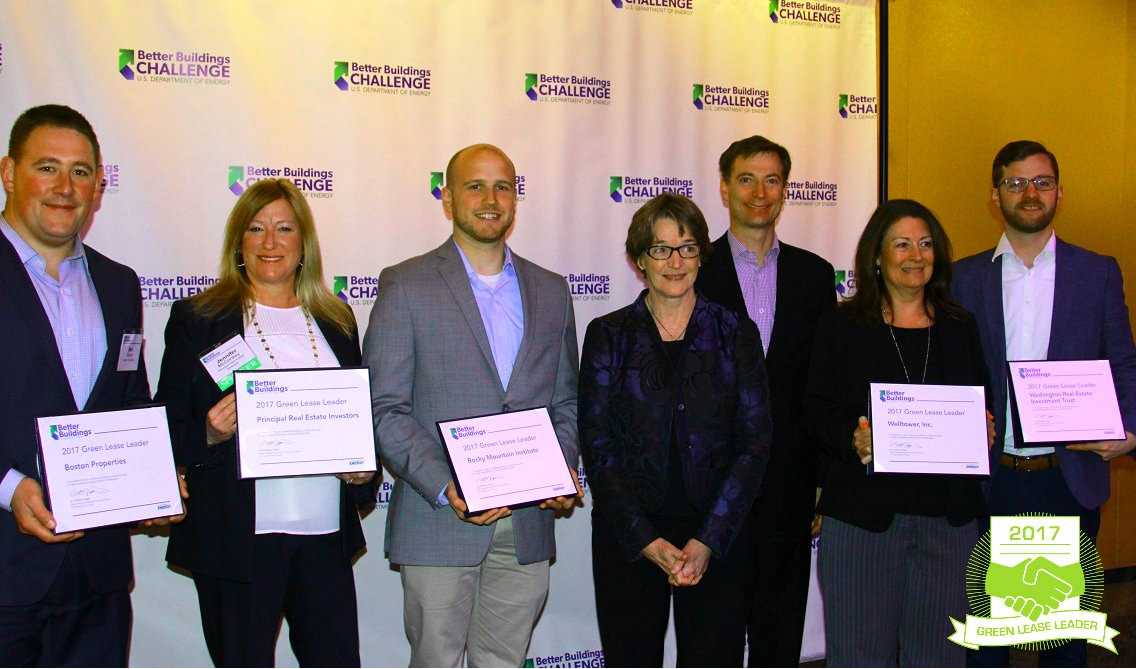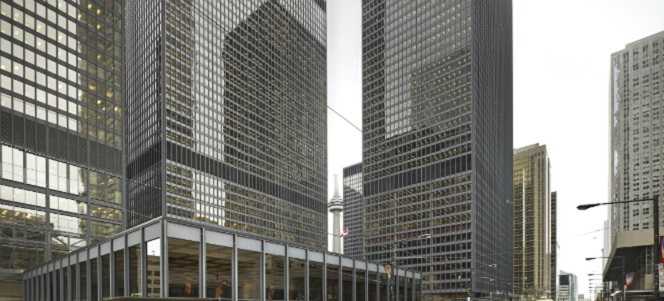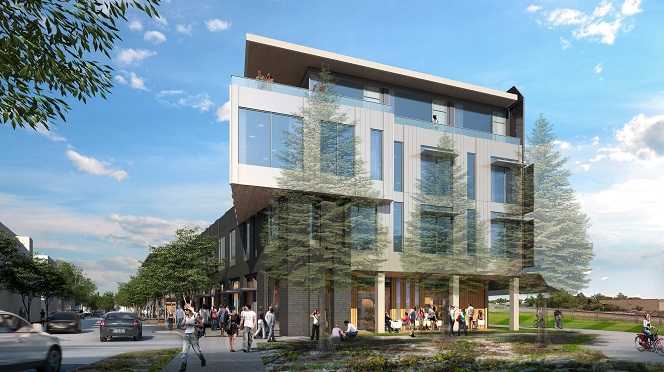This summer, the Institute for Market Transformation (IMT) and the U.S. Department of Energy’s Better Buildings Alliance announced the new class of Green Lease Leaders, a designation to recognize companies that have successfully modernized their lease language to include energy efficiency, and encourage landlord-tenant collaboration around sustainability goals. Rocky Mountain Institute (RMI) was among those awarded for its net-zero lease at Boulder Commons, soon to be home to RMI’s Boulder office in August 2017.
In addition to setting a standard for what constitutes a green lease, the Green Lease Leaders program was established to promote green buildings by helping to overcome the invisible barrier of split incentives that exists between landlords and tenants (i.e., the misalignment of efficiency costs and benefits since tenants pay utility bills yet owners control the assets). Such split incentives have historically held back investments in building performance improvements.

Honoring the 2017 Green Lease Leaders at the Better Buildings Summit. Image: IMT
Overcoming this historical contractual hurdle may not sound as exciting as other climate and energy solutions, such as developing methane-sniffing drones to detect natural gas leaks, but it has significant environmental and economic implications. The building sector is responsible for more than one-third of U.S. carbon emissions, and half of all commercial buildings are leased. In its 2015 report, IMT estimated that green leases have the potential to reduce energy consumption in U.S. office buildings by as much as 22 percent, and—when properly executed—can provide the leased U.S. office market $3.3 billion in annual cost savings while yielding higher quality spaces for tenants and competitive advantage for owners.
Four years into the program, IMT has seen green leasing evolve beyond managing split incentives through contract language, to trying to keep pace with the ever-evolving green building sector.
“Continuing to push the envelope is critical in ensuring that leases can enable—rather than hinder—the shift toward high-performance buildings,” said Adam Sledd, IMT director of market engagement. “As green buildings have become mainstream and net-zero buildings and districts gain traction nationally, agreements need to become more cutting edge and sophisticated.”
Here are the three top trends in the green leasing space observed by this year’s roster of Green Lease Leaders that can continue to push the industry forward.
1: Tenants Are Raising the Roof
According to IMT, the most innovative developments in green leasing are tenant driven. “Tenants are increasingly setting their priorities for spaces that align with company values,” Sledd said. “They understand the connection between green buildings and employee health, productivity, satisfaction, recruitment, and retention.”
A keener understanding of company values—and how a high-performance workspace can enhance these values—has meant tenants are able to be clearer about their expectations and demands, adding much more detail and specificity to their leases.
TD Bank—also a 2017 Green Lease Leader—is one such example of what is possible with a strong tenant vision. Its headquarters in downtown Toronto became the world’s first project certified under v1 of the WELL building standard, a performance-based system for measuring, certifying, and monitoring features that impact human health and well-being through air, water, nourishment, light, fitness, comfort, and mind. The 18-month process to optimize 25,000 square feet of leased space was tenant driven, but ultimately did have strong support and coordination between both tenant and landlord.

Image: Canadian Property Management
A representative of TD Bank’s landlord, Cadillac Fairview, cited that an understanding that “human capital was a driver of value and measuring the quality of real estate” was a key motivator in supporting the project during a presentation at the Canada Green Building Council’s national conference in 2016.
2: Owners Are Raising the Floor
Across the board, landlords are becoming much more willing to work with tenants who demand green leases, but are less likely to make the first move or push for more innovative solutions.
Many companies have taken years to implement even the most basic green lease language into their contracts such as requiring the installation of a sub-metering system or LED lighting in tenant spaces. “While this is admirable,” according to Sledd, “it is hardly scratching the surface of driving building performance at the rate or scale needed for green leasing to become the norm offered from landlords, not the exception.”
One major exception is the U.S. General Services Administration, the nation’s biggest landlord, which owns and manages more than 1 billion square feet of space. As a key industry influencer, it has actively led—both on the landlord and tenant sides—the development, implementation, and amplification of green lease structures. These structures align federal government goals (like the effective stewardship of taxpayer dollars and infrastructure resilience) with tenant priorities (like comfortable, state-of-the-art workspaces), establishing a model for the private sector.
RMI and IMT recently played a key role working with a GSA task group to assemble simple, actionable, voluntary green lease criteria and sample lease language with the ultimate goal of increasing the supply of high-performance office buildings for GSA and other tenants to lease. The matrix of criteria and sample lease language can be found here.
3: Cooperation Can Be Groundbreaking
When owners and tenants work together from the get-go, the result can be groundbreaking. While this is a less common model, it is important in creating leases that truly push the envelope.
For example, RMI’s net-zero lease at the Boulder Commons is the first ever net-zero energy lease in Colorado, and the first in the U.S. for a multitenant development of its size, at more than 100,000 square feet. Although the value proposition for an owner-occupied net-zero building is clear (lower energy and maintenance costs, higher employee productivity, and fewer employee sick days), the value proposition for both landlords and tenants in a leased building depends on a more complex relationship. How do you true up energy use and costs on a monthly basis when they are typically calculated on an annual basis?

Renderings of Boulder Commons, courtesy of Morgan Creek Ventures
RMI worked from the outset with developer Morgan Creek Ventures and legal team Holland and Hart to manage this complexity and develop a new industry model for net-zero energy leases that helped both parties meet their goals.
“Boulder Commons is setting a new bar for sustainability, and our tenants share the belief that how we act as a company matters,” said Andrew Bush from Morgan Creek Ventures. “Having RMI as an anchor tenant as well as a partner in developing a lease structure that aligned landlord and tenant goals and incentives around net zero on an annual basis pushed us further than we could have ever gone ourselves.”
Moving the Market Forward
Boulder Commons is merely the tip of the iceberg in scaling leases that benefit owners, landlords, tenants, and the environment.
“The buildings industry is notoriously an industry of followers. Nobody wants to go first,” said RMI manager Cara Carmichael. “We have gone first, and we want to share what we learned to help push the market to zero using smart lease structures. If we can’t get our heads around a solution that’s broadly adoptable to address issues around split incentives and green leasing, then we are never going to achieve our climate objectives.”
A version of RMI’s lease at Boulder Commons is publicly available on RMI’s website to encourage others to follow suit, (click on the image to the right to download).
According to IMT and RMI, all the tools are in place for an owner or tenant that wants to pursue a green lease to do so with very little effort. IMT’s Green Lease Library is a full clearinghouse of publicly available toolkits, case studies, and other resources needed to implement a green lease from the owner or tenant perspective. What’s needed now is to connect the dots between tenant demands and owner perceptions.
“Offering high-performance spaces and green lease options is a competitive advantage, not a liability for owners,” said Sledd. “IMT will continuing to share lessons and successes, and celebrate leaders to help accomplish these goals.”
Now, IMT and industry trade groups are working hand-in-hand with U.S. landlords and tenant companies to expand the use of energy-aligned leasing practices through the Landlord-Tenant Energy Partnership. The Partnership is providing businesses a road map to achieve high performance, as well as piloting new energy-saving approaches in leasing, site selection, and more. IMT staff is also collaborating with small business owners and tenants that own or occupy smaller commercial buildings, which make up 94 percent of commercial real estate buildings in the U.S.
Meanwhile, stay tuned for an all new Green Lease Leaders website, which will be launched in September, and keep an eye on the next round of Green Lease Leaders—or consider becoming one yourself!
Kelly Vaughn is a marketing manager with RMI’s communications team, where she manages communications strategy and campaign implementation for the buildings and development teams.
